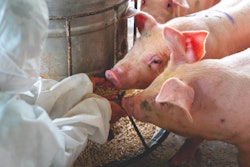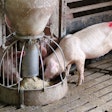
Trouw webinar highlights two-pronged approach to managing heat stress in livestock
As global warming and genetic advances cause heat stress to become more common, understanding and managing this complex condition will become increasingly important to livestock producers, Trouw Nutrition‘s Soheil Varasteh told attendees of a webinar on July 30.
Twenty of the world’s hottest years have occurred during the past 22 years, and chances are 2020 will top the charts once again, Varasteh, a regional director for Trouw Nutrition, said. On top of this, modern livestock are more susceptible to heat stress because they’ve been bred to grow faster, which causes them to produce more heat.
Exposure to heat stress can trigger several complicated conditions that persist long after the animal’s exposure ends. During exposure, Varasteh said, affected animals exhibit panting, reduced feed intake, slower growth and decreased egg and milk production. Cattle, Varasteh pointed out later in the webinar, are especially prone to heat stress.
“It is clear that ruminants in general and also dairy cows are having the highest losses due to heat stress because they are the animal with the least ability to cope with hot conditions,” he said. “Even temperatures that are moderate in other species can put cows in heat stress.”
In ruminants, Varasteh said, heat stress can trigger acidosis in the rumen, which can cause an imbalance in the rumen’s microbiome and enable certain fungal infections to take root.
This is in addition to symptoms seen across species, which Varasteh described as falling into three broad categories. Heat stress triggers the generation of free radicals, particles in the body that cause damage to cells and tissues. It can also trigger dehydration and electrolyte imbalances, and changes in how the body distributes blood can starve internal organs of critical resources, damaging the intestine and digestive organs in particular.
“One of the first things the body does under heat stress is to shift the blood away from organs to the skin to release heat,” Varasteh said. “This reaction is so sharp and so intense that ultimately it leads to intestinal hypoxia, or hypoxia of other organs.”
The resulting damage to the intestine can trigger leaky gut, which intensifies the impact of infections and even mycotoxins, Varasteh said.
Because of the complexity of the condition, addressing heat stress requires a two-pronged approach, Varasteh said. Strategies such as decreased stocking density, maintaining a lower drinking water temperature and feeding during cooler parts of the day can help prevent heat stress. If possible, air circulation can induce wind chill and decease the effects of heat stress by 30-40%, according to Varasteh.
Feeding strategies can mitigate the remaining effects, he continued, explaining that maintaining water intake, electrolyte balance and including antioxidants are critical steps. Varasteh said producers should take care to select an antioxidant source that is fat- and water-soluble, and also recommended products to improve water retention and maintain gut integrity.
















